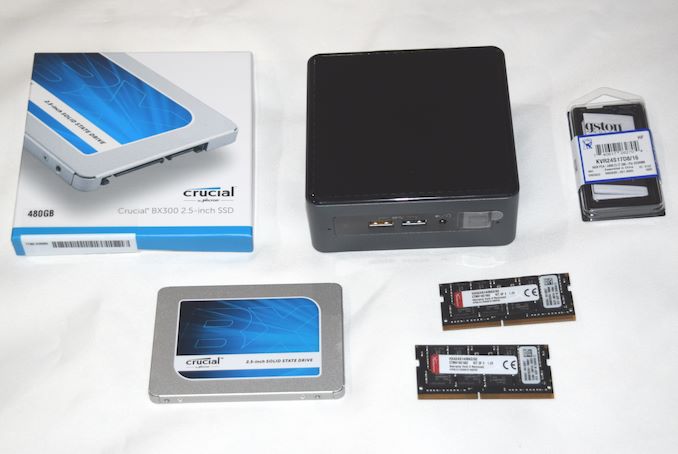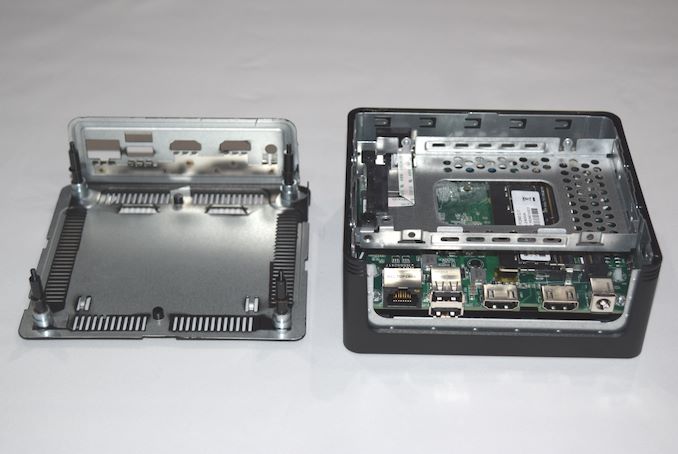Gemini Lake SFF PC Showdown: Intel's June Canyon (NUC7PJYH) and ECS's LIVA Z2 Reviewed
by Ganesh T S on December 20, 2018 8:00 AM ESTConcluding Remarks
Earlier I briefly touched upon the HTPC capabilities of the two Gemini Lake PCs. Of the two, the ECS LIVA Z2 is particularly attractive due to its passively cooled nature. Gemini Lake has one of the most power-efficient and full-featured video decoders in the market - It is capable of even handling VP9 Profile 2 in hardware. The only disappointing aspect from a HTPC viewpoint is that HDR is not supported. Consumers looking for a full-featured HTPC setup have to look beyond Gemini Lake for their needs. That said, if HDR is not a concern (as is likely in most TVs installed in a secondary location), Gemini Lake in general and the ECS LIVA Z2 in particular are good choices to consider.
Moving on to the power consumption aspect, we recorded the maximum sustained at-wall numbers while running the AIDA64 System Stability Test.

These numbers show that Gemini Lake, despite running at the same clocks as Apollo Lake, has managed to provide better performance per watt. The raw numbers are approximately the same when two systems with similar cooling situations are compared.
The Intel June Canyon NUC7PJYH Build Components
Coming to the business end of the review, Gemini Lake has shown itself to be a solid successor to Apollo Lake. Doubling the internal cache has led to significant performance increase in many real-life workloads. This is particularly evident when comparing the performance numbers of the NUC7PJYH (June Canyon) and the older NUC6CAYH (Arches Canyon). In addition to the performance bump, we also have better Wi-Fi capabilities. The product is not perfect, though - the installation of a 2.5" drive is not as easy as it is in some of the other UCFF PCs such as the ECS LIVA Z2. With the rise in popularity of M.2 SSDs, Intel could as well replace the 2.5" drive caddy with a M.2 SATA SSD-only slot on the motherboard, and reduce the system volume. The default fan curves could always use some tweaking, but, that is more of a subjective issue. These are very minor issues.
Accessing the Drive Caddy and the SODIMM Slots in the ECS LIVA Z2
On the other hand, the move from the ECS LIVA Z to the Z2 is a mixed bag. While the all-important fanless nature is still present, the retaining of aspects such as the measly 32GB of eMMC (with Windows 10 Home pre-installed) do not make for a good user experience. 32GB of eMMC may suffice for certain single-purpose industrial application systems, but, as a general-purpose PC, consumers will need to install an additional 2.5" SATA drive (similar to what we had to do for processing this review). Some consumers may appreciate the replacement of the mini-DP port in the LIVA Z with a full-sized HDMI one in the LIVA Z2. However, the sacrifice of a second LAN port for this is not a particularly good trade-off. That said, the performance increase enabled by Gemini Lake still makes the ECS LIVA Z2 a good choice over the ECS LIVA Z for most applications.












59 Comments
View All Comments
mode_13h - Sunday, December 23, 2018 - link
These aren't just light desktops, and perhaps you overestimate the size of the HTPC market.My employer actually uses NUCs for another purpose, entirely. A lot of things that would formerly be handled by lightweight servers can be done with a NUC. If you need to do some processing on-site (i.e. cannot move it into the cloud, or on a VM hosted by a big server), then NUCs are a pretty good option. I wish they had ECC, but it's not needed for our purpose (and there are industrial mini PCs that have it).
eastcoast_pete - Monday, December 24, 2018 - link
I agree with you that, for the use you describe, these NUCs are (almost, no ECC) perfectly fine. I disagree on underestimating the size of the HTPC market. Unfortunately, there are plenty of people who think hey, this could be a cheap solution for my media needs.I wish Ganesh would have put a clear statement in his review along the lines of " these units are okay or even excellent for situations where you need a compact PC that can run general office software or on-site processing. However, if you hope to put these Gemini lake systems to use as HTPCs, you're better off looking elsewhere" or similar.
GreenReaper - Sunday, December 23, 2018 - link
To be honest, these have not really been positioned as HTPC, but as ultra-compact form-factor PCs. Other places describe it as a "PC replacement" or for "entry-level digital signage", e.g.:"The NUC7PJYH kit also comes with dual Ultra HD 4K display support via two full-sized HDMI ports, consumer infrared, and a TOSLINK audio jack, they’ve got everything they need to stream media, play, or finish that last-minute presentation. In addition, with 3.2x better graphics, you can create robust entry-level digital signage at entry-level prices for your SMB customers."
If you are looking for more in a NUC, and in particular HDR support, you probably want to be looking at Bean Canyon (CFL-U) or Hades Canyon (KBL-U) as described in https://www.anandtech.com/tag/htpc
speculatrix - Monday, December 31, 2018 - link
The TOSLink port works perfectly under windows 10, with dd5.1 out.Oxford Guy - Friday, December 28, 2018 - link
"For example, in the average office scenario, it might not be worth purchasing a noisy and power-hungry PC just because it ends up with a 2000 score in the SYSmark 2014 SE benchmarks. In order to provide a balanced perspective, SYSmark 2018 also allows vendors and decision makers to track the energy consumption during each workload. In the graphs below, we find the total energy consumed by the PC under test for a single iteration of each SYSmark 2018 workload. For reference, the calibration system consumes 5.36 Wh for productivity"versus 6.03 for the LIVA and 6.60 for the NUC. So, they both fail the office work test. That is not what I expected nor what most would expect, since Atom in particular is supposed to be more, not less, energy-efficient for things like office work. Is it due to the i3-7100 being able to finish tasks more quickly, a storage speed bottleneck, or both? I assume it's the first one.
It's also rather sad how slow these are when compared with Piledriver parts in the Cinebench tests. Even single-threaded Cinebench, which exposes how slow Piledriver is when compared with Intel's real CPUs, makes these low bad. The multicore performance is pitiful. Yes, I realize that Piledriver uses more energy. However, a processor like the 8370E is hardly an energy nightmare if it's not overclocked and it kicks the tar out of these chips (100 for single-threaded and 614 for multithreaded). The 8320E was ultra cheap at MicroCenter and even qualified for the motherboard price reduction. Color me underwhelmed when a design from 2011/2012 that wasn't much of an upgrade when it came out manages to greatly outperform parts being sold on the cusp of 2019, without using a tremendous amount of energy. Clearly, an officer worker would be happier with an 8320E than one of these CPUs and it's not even for sale anymore — let alone a Sandy Bridge chip which has better single-threaded performance.
These boxes, then, seem to be for more niche activities, like HTPC use.
Oxford Guy - Friday, December 28, 2018 - link
"makes these low bad" unfinished sentence... oops: "Makes these low low end chips seem particularly bad."speculatrix - Monday, December 31, 2018 - link
I bought a June Canyon NUC specifically because of the TOSLink optical output. I can vouch that, with the right drivers under windows 10 you can get Dolby Digital out, when playing Netflix from the Netflix app, or movies with the right audio codecs with VLC.pseudoid - Wednesday, January 23, 2019 - link
I thought I was in the PC aisle of Fry's Electronics store. Yeah, here it is 2019 and they are still trying to offload the NUC7s at retail prices. I bought NUC8s (one w/i5 and the other with the i7) in December 2018 and I'm tickled pink.haralake - Friday, September 3, 2021 - link
Hello! I would like to power NUC7PJYH NUC after a power failure. Specifically I want to use a mini ups with 12v 2a 30watt output. I read in the model information that 12-19v power supply is possible on NUC7PJYH, so I will not have a problem with 12v. But I would like to know if the 2a and 30watt provided by my ups are enough for NUC7PJYH.